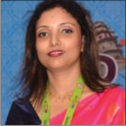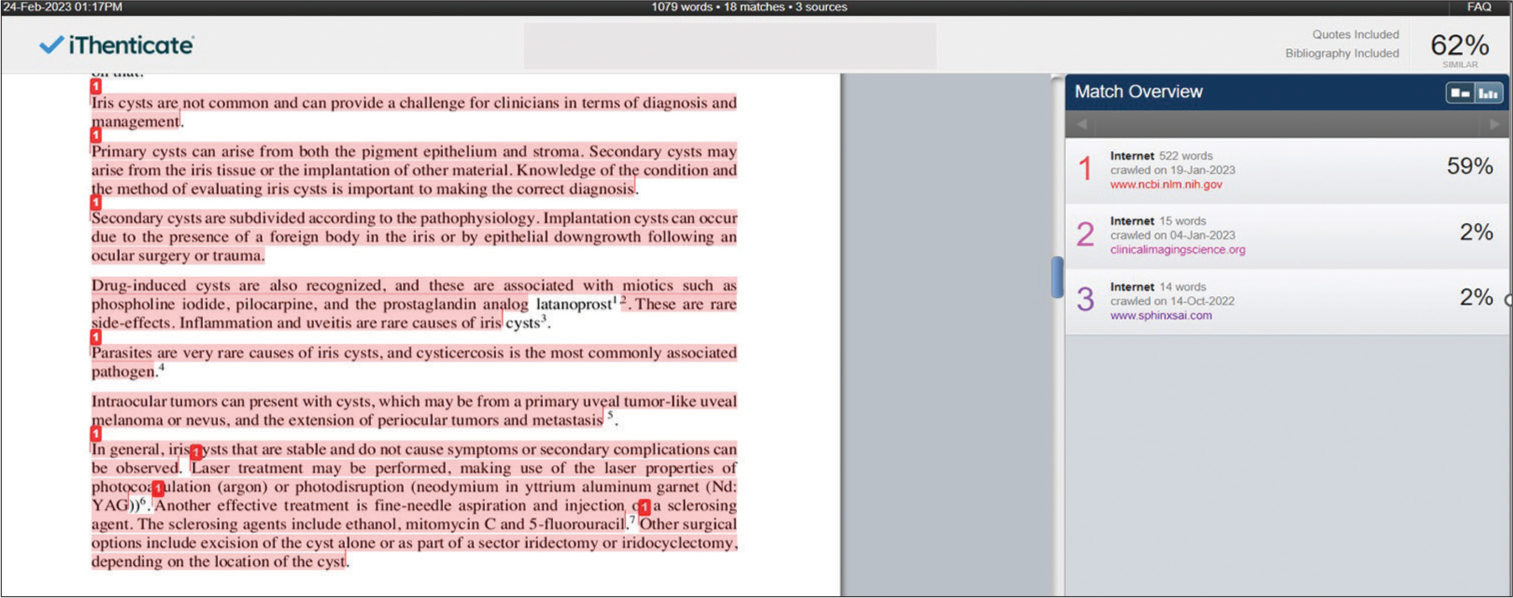Translate this page into:
The bug called Plagiarism

-
Received: ,
Accepted: ,
How to cite this article: Choudhury H. The bug called Plagiarism. J Ophthalmic Res Pract 2023;1:47-9. doi: 10.25259/JORP_41_2023
With new beginnings, as we celebrate the success of the inaugural issue of the Journal of Ophthalmic Research and Practice (JORP), I bring to you glad tidings. JORP has now acquired its unique online and print International Standard Serial Number (ISSN). This number enables any serial publication to be identified uniquely all over the globe. Journals with ISSN are included in the International Serials Directory giving it instant recognition and enhanced visibility worldwide. JORP volume 1, issue 1 has been extremely well received, and the journal website statistics are a testimony to its widespread acceptance. The full-text views of all the papers published in the first issue stands at 1454 in just 2 months, and there have been 458 portable document format downloads from that issue (till 20.8.2023).
As promised, we bring to you the second issue of JORP within the same calendar year, thus adhering to the bi-annual nature of the journal. In the present issue, we are proud to present a guest editorial from Dr. Namrata Sharma, Chairman Scientific Committee of All India Ophthalmological Society. The first-ever woman editor of the Indian Journal of Ophthalmology, Dr. M. Vanathi has gracefully accepted to send an invited review article.
Submissions have been encouraging in the inception stage but have lowered gradually. There has been a dearth of original article submissions that reflects our lack of motivation for research work. While navigating the submissions, a frequent bug that crept up was plagiarism. This prompted us to dedicate this editorial to an often neglected and possibly unintentional form of literary piracy called plagiarism. Plagiarism is the use of published literature in one’s own literary work, without giving due credit to the author of the original work. Encyclopedia Britannica defines plagiarism as “the act of taking the writings of another person and passing them off as one’s own.”[1] When an author starts to write a paper, the most logical and accessible source of inspiration is the cyberspace. With just the click of a button, the vast ocean of literature appears on our computer screens. The “introduction” and “discussion” part of a paper inadvertently becomes a “copy– paste” job, thus raising the similarity index of an article beyond permissible limits.
A certain portion of plagiarism is quite common in scholarly articles, wherein the author substitutes words in the original texts with synonyms and edits the text.[2] Copying any series of more than three words without citing qualifies as stealing literary work from others.[3] Our medical curriculum (undergraduate and postgraduate) does not devote any chapter on plagiarism; which accounts for the lack of knowledge of medical graduates on this topic. Authors are lured into copying others’ work, for the sheer urgency of publishing. In India, there is a mandatory criteria for research publication for medical college faculties to get promoted.[4] This has led to the mushrooming of predatory journals that enables the author to get published within hours in lieu of a minimal financial exchange. India has the highest number of journals indexed with Index Copernicus that has questionable credibility. Predatory journals possess an overtly active editorial board and reviewers who process the article bypassing the peer-review process.[5] This creates a huge production of the so-called “promotion paper” from our country.[6] The author, thus unknowingly, falls prey to the habit of copying/recycling published literature.
Plagiarism contributed to 9.8% retraction in an analysis of 2000 retracted articles indexed in PubMed (2005). Japan, China, and India were among the countries having higher incidences of plagiarism.[7] Another analysis done on 835 retracted PubMed publications between 2008 and 2012 showed the highest plagiarism among Italian (66.7%) and Indian (36.7%) authors.[8] Nundy et al. elaborated on the causes of rampant plagiarism among Indian authors.[9] The compulsory thesis submission by postgraduate degree students within a stipulated time rings in the “copy–paste” culture in them. Lack of exposure to research methodology, ignorance of publication ethics, inadequate vocabulary, slapdash checking by guides, and absence of sanction contribute to plagiarism.
Detection of plagiarism – Multiple paid and free plagiarism checking software is available in the digital world. Some of them are “Grammarly,” “Duplichecker,” “Quetext,” “Turnitin,” “iThenticate,” and “Plagiarism detect.” JORP reviewers and editors have access to “iThenticate” plagiarism detection software, and we conduct routine checks on all articles before a peer-review process. However, such software is not foolproof, and some articles may escape detection by smart paraphrasing.[10] The onus ultimately lies on the author to refrain from intellectual forgery.
Mantras to avoid plagiarism – Authors must advocate originality and fair practice while scripting a research paper. All original sources must be cited appropriately.[11] Never copy whole paragraphs from previously published papers as iThenticate detects a sentence to be plagiarized if 80% of words are copied from another paper.[12] [Figure 1] An easy way to avoid plagiarism is to rephrase the sentence with synonyms while still maintaining the sense of the sentence [Figure 2]. When paraphrasing has been applied, reference should still be provided.[11] In the brief tenure of 8 months, JORP has encountered 7.69% self-plagiarism, wherein the author submits their own previously published data to a new journal for repeat publication.

- Screenshot of a plagiarism report showing 62% plagiarism.

- Screenshot of the same article, with paraphrasing and elimination of unnecessary texts, showing 3% plagiarism.
I acknowledge that there shall be some hiccups, as the journal is in its nascent stage. I recognize with gratitude all my team members on the editorial board, and the reviewers who have taken great efforts to expedite the peer-review process. As more authors and readers repose their trust in JORP, only then can it reach the heights where we visualize it to be. I bid adieu with the hope of enhanced, quality contributions from the ophthalmic fraternity of our country.
References
- Plagiarism and unethical practices in literature. Indian J Ophthalmol. 2009;57:481-5.
- [CrossRef] [Google Scholar]
- Available from: https://www.unk.edu/academics/biology/_files/plagiarism%20policy.pdf [Last accessed on 2023 Sep 14]
- Amended criteria for promotion of medical teachers: A step towards sound research and publication. Indian J Ophthalmol. 2020;68:2321-2.
- [CrossRef] [PubMed] [Google Scholar]
- Pressure to publish: Index copernicus and predatory journals are helping (?) academicians. Indian Dermatol Online J. 2019;10:332-4.
- [CrossRef] [PubMed] [Google Scholar]
- Reduce burden of questionable publication from Indian authors: Young academicians' perspective. Muller J Med Sci Res. 2018;9:120-1.
- [CrossRef] [Google Scholar]
- Misconduct accounts for the majority of retracted scientific publications. Proc Natl Acad Sci USA. 2012;109:17028-33.
- [CrossRef] [PubMed] [Google Scholar]
- The ethics of scholarly publishing: Exploring differences in plagiarism and duplicate publication across nations. J Med Libr Assoc. 2014;102:87-91.
- [CrossRef] [PubMed] [Google Scholar]
- How to check for plagiarism? In: How to practice academic medicine and publish from developing countries?. Singapore: Springer; 2022.
- [CrossRef] [Google Scholar]
- Plagiarism in the context of education and evolving. J Korean Med Sci. 2017;32:1220-7.
- [CrossRef] [PubMed] [Google Scholar]
- What is plagiarism and how to avoid it? Indian J Orthop. 2016;50:581-3.
- [CrossRef] [PubMed] [Google Scholar]
- Plagiarism in submitted manuscripts: Incidence, characteristics and optimization of screening-case study in a major specialty medical journal. Res Integr Peer Rev. 2016;1:13.
- [CrossRef] [PubMed] [Google Scholar]





